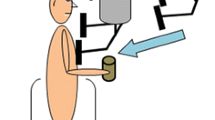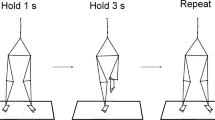Abstract.
Voluntary arm-raising movement performed during the upright human stance position imposes a perturbation to an already unstable bipedal posture characterised by a high body centre of mass (CoM). Inertial forces due to arm acceleration and displacement of the CoM of the arm which alters the CoM position of the whole body represent the two sources of disequilibrium. A current model of postural control explains equilibrium maintenance through the action of anticipatory postural adjustments (APAs) that would offset any destabilising effect of the voluntary movement. The purpose of this paper was to quantify, using computer simulation, the postural perturbation due to arm raising movement. The model incorporated four links, with shoulder, hip, knee and ankle joints constrained by linear viscoelastic elements. The input of the model was a torque applied at the shoulder joint. The simulation described mechanical consequences of the arm-raising movement for different initial conditions. The variables tested were arm inertia, the presence or not of gravity field, the initial standing position and arm movement direction. Simulations showed that the mechanical effect of arm-raising movement was mainly local, that is to say at the level of trunk and lower limbs and produced a slight forward displacement of the CoM (1.5 mm). Backward arm-raising movement had the same effect on the CoM displacement as the forward arm-raising movement. When the mass of the arm was increased, trunk rotation increased producing a CoM displacement in the opposite direction when compared to arm movement performed without load. Postural disturbance was minimised for an initial standing posture with the CoM vertical projection corresponding to the ankle joint axis of rotation. When the model was reduced to two degrees of freedom (ankle and shoulder joints only) the postural perturbation due to arm-raising movement increased compared to the four-joints model. On the basis of these results the classical assumption that APAs stabilise the CoM is challenged.
Similar content being viewed by others
Author information
Authors and Affiliations
Additional information
Received: 2 December 1999 / Accepted in revised form: 8 August 2000
Rights and permissions
About this article
Cite this article
Pozzo, T., Ouamer, M. & Gentil, C. Simulating mechanical consequences of voluntary movement upon whole-body equilibrium: the arm-raising paradigm revisited. Biol Cybern 85, 39–49 (2001). https://doi.org/10.1007/PL00007995
Issue Date:
DOI: https://doi.org/10.1007/PL00007995




